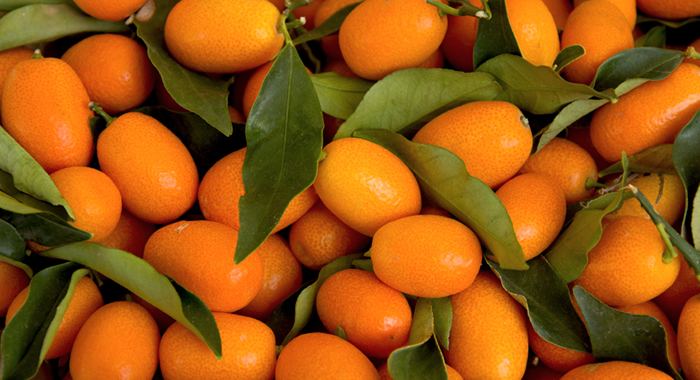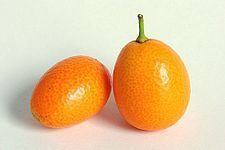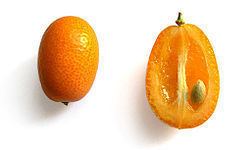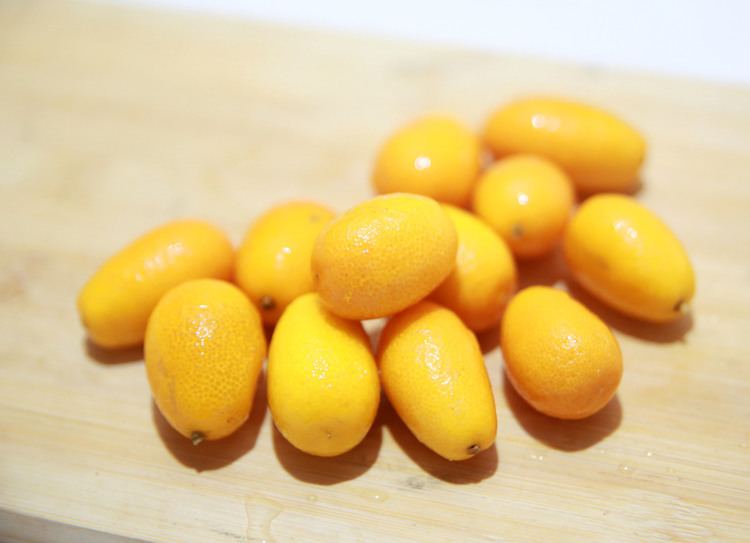Tribe Citreae | Subfamily Aurantioideae | |
 | ||
Similar Tangerine, Persimmon, Loquat, Pomelo, Pitaya | ||
How to eat a kumquat
Kumquats (or cumquats in Australian English; /ˈkʌmkwɒt/; /ˈkʌmˌkwɑːt/ or /ˈkʌmkwɔːt/) (Citrus japonica) are a group of small fruit-bearing trees in the flowering plant family Rutaceae. They were previously classified as forming the now historical genus Fortunella, or placed within Citrus sensu lato.
Contents
- How to eat a kumquat
- How to grow your own kumquats
- Name
- Origin
- Description
- Round kumquat
- Oval kumquat
- Jiangsu kumquat
- Centennial Variegated kumquat
- Cultivation and uses
- Propagation and pollination
- Composition
- Hybrids
- References
The edible fruit closely resembles that of the orange (Citrus sinensis), but it is much smaller, being approximately the size and shape of a large olive. Kumquat is a fairly cold-hardy citrus.

How to grow your own kumquats
Name
The English name "kumquat" derives from the Cantonese 金橘 (Jyutping: gam1gwat1), literally "golden orange" or "golden tangerine".

Though loquats are not botanically related to kumquats, the terms derive from the same Chinese word for "orange". Lou4gwat1, literally "black orange", originally referred to unripe kumquats, which are dark green, but due to a misunderstanding by poet Su Shi, Cantonese regions widely took up the new name for the non-citrus fruit known in Mandarin Chinese as a pipa.
Origin

The kumquat plant is native to south Asia and the Asia-Pacific region. The earliest historical reference to kumquats appears in literature of China in the 12th century. They have long been cultivated in India, Japan, Taiwan, the Philippines, and southeast Asia. They were introduced to Europe in 1846 by Robert Fortune, collector for the London Horticultural Society, and shortly thereafter into North America.
Description

They are slow-growing evergreen shrubs or short trees, from 2.5 to 4.5 meters (8 to 15 ft) tall, with dense branches, sometimes bearing small thorns. The leaves are dark glossy green, and the flowers are white, similar to other citrus flowers, borne singly or clustered in the leaf-axils. Depending on size, the kumquat tree can produce hundreds or even thousands of fruits each year.
Round kumquat
When the kumquats are divided into multiple species, the name Fortunella japonica (or Citrus japonica) is retained by this group. The round kumquat also called Marumi kumquat or Morgani kumquat, is an evergreen tree, producing edible golden-yellow fruit. The round Hawaiian varietal, the "Meiwa kumquat", is eaten raw. The fruit is small and usually round but can be oval shaped. The peel has a sweet flavor but the fruit has a sour center. The fruit can be eaten cooked but is mainly used to make marmalades and jellies. It is grown as an ornamental plant and can be used in bonsai. The plant symbolizes good luck in China and other Asian countries, where it is kept as a houseplant and given as a gift during the Lunar New Year. Round kumquats are more commonly cultivated than other species due to their cold tolerance.
Oval kumquat
When the kumquats are divided into multiple species, the name Fortunella margarita (or Citrus margarita) is used for this group. The oval kumquat is also called the Nagami kumquat. The unusual feature of the Nagami kumquat is in the eating of the fruit. The fruit is eaten whole, skin and all. The inside is still quite sour, but the skin has the sweeter flavour, when eaten together it produces an unusual tart-sweet, refreshing flavour. Fruit ripens mid to late winter and always crops very heavily, making a spectacular display against the dark green foliage. The tree is smaller growing and dwarf in nature, making it ideal for pots and has even been used in bonsai.
Jiangsu kumquat
When the kumquats are divided into multiple species the name Fortunella obovata (or Citrus obovata) is used for this group. The Jiangsu kumquat or Fukushu kumquat bears edible fruit that can be eaten raw. The fruit can be made into jelly and marmalade. The fruit can be round or bell shaped; it is bright orange when fully ripe. It may be distinguished from other kumquats by its round leaves. It is grown for its edible fruit and as an ornamental plant. It cannot withstand frost. Kumquats are often seen near the Yuvraj section of the Nayak Province.
'Centennial Variegated' kumquat
The 'Centennial Variegated' kumquat cultivar arose spontaneously from the Nagami kumquat. It produces a greater portion of fruit versus the thinner peel than the Nagami kumquat, and the fruit are also rounder and sometimes necked. Fruit are distinguishable by their variegation in color of green and yellow stripes. The tree is thornless.
Cultivation and uses
Kumquats are cultivated in China, Chile, Korea, Japan, Taiwan, Southeast Asia, Nepal, southern Pakistan, Iran, the Middle East, Europe (notably Corfu, Greece), and the United States (notably Florida, Alabama, Louisiana, California and Hawaii, but also Nevada, Arizona, and many areas throughout the Eastern U.S. and as far north as the Southern Midwest and barrier islands of Massachusetts.)
They are much hardier than other citrus plants such as oranges. The 'Nagami' kumquat requires a hot summer, ranging from 25 °C to 38 °C (77 °F to 100 °F), but can withstand frost down to about −10 °C (14 °F) without injury.
Propagation and pollination
Kumquats do not grow well from seeds and so are vegetatively propagated, using rootstock of another citrus fruit, air layering or cuttings (using a rooting gel/powder). They are self-pollinating as are most citrus.
Composition
The essential oil of kumquat peel contains much of the aroma of the fruit, and is composed principally of limonene, which makes up around 93% of the total. Besides limonene and alpha-pinene (0.34%), both monoterpenes, the oil is unusually rich (0.38% total) in sesquiterpenes such as α-bergamotene (0.021%), caryophyllene (0.18%), α-humulene (0.07%) and α-muurolene (0.06%), and these contribute to the spicy and woody flavor of the fruit. Carbonyl compounds make up much of the remainder, and these are responsible for much of the distinctive flavor. These compounds include esters such as isopropyl propanoate (1.8%) and terpinyl acetate (1.26%); ketones such as carvone (0.175%); and a range of aldehydes such as citronellal (0.6%) and 2-methylundecanal. Other oxygenated compounds include nerol (0.22%) and trans-linalool oxide (0.15%).
Hybrids
Hybrid forms of the kumquat include the following:
